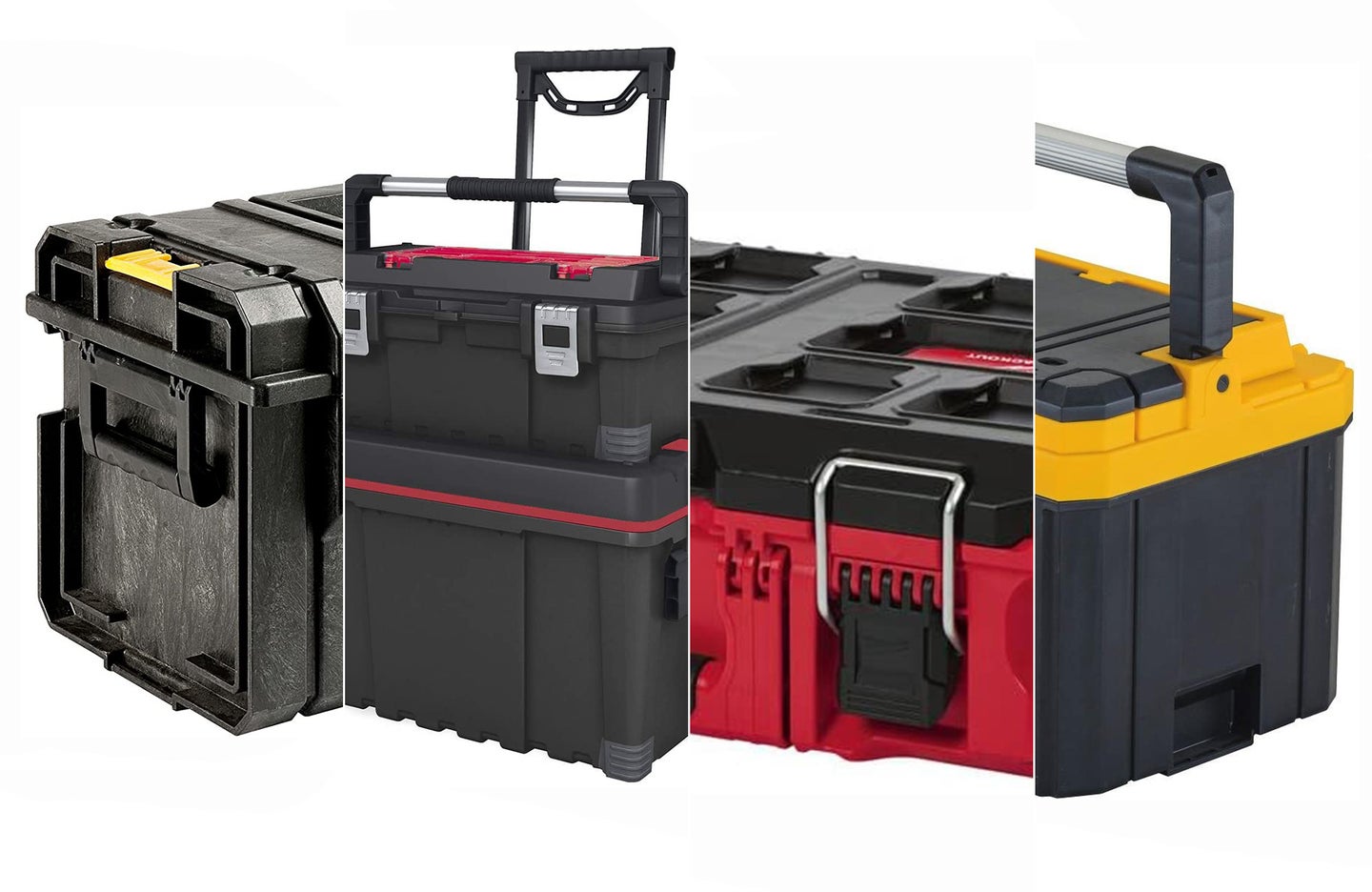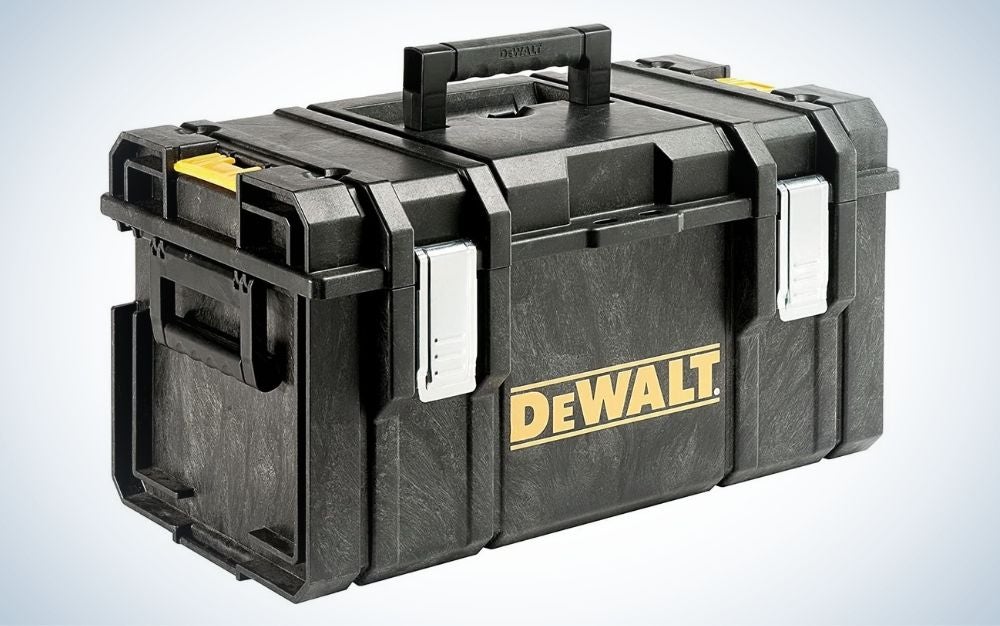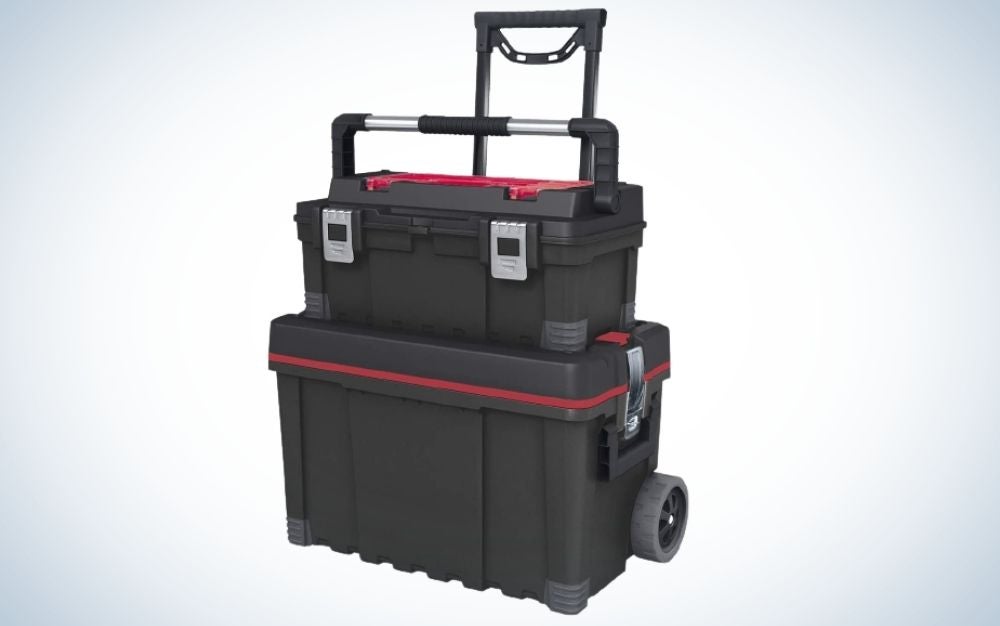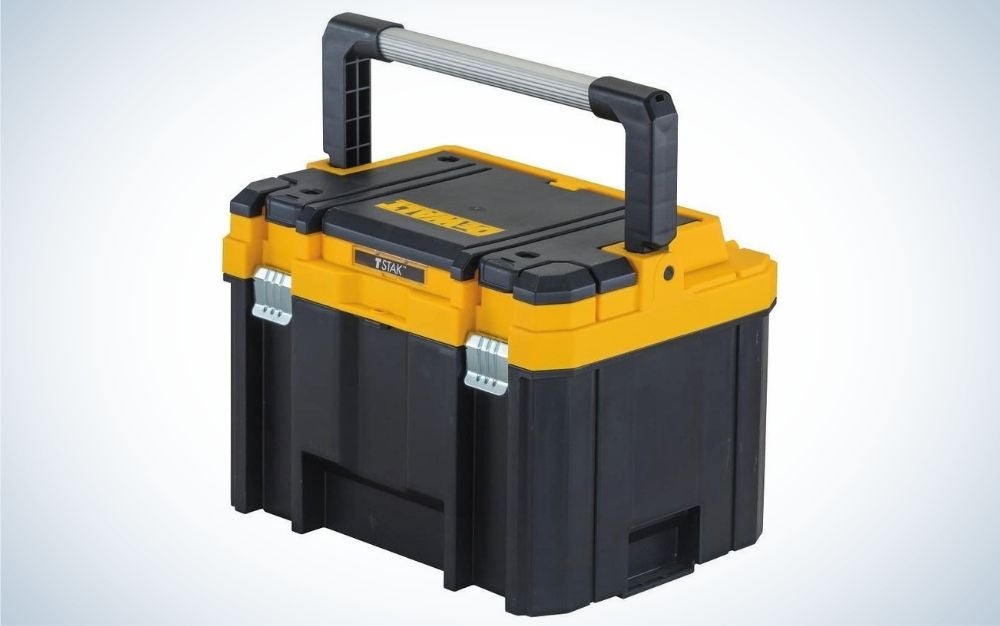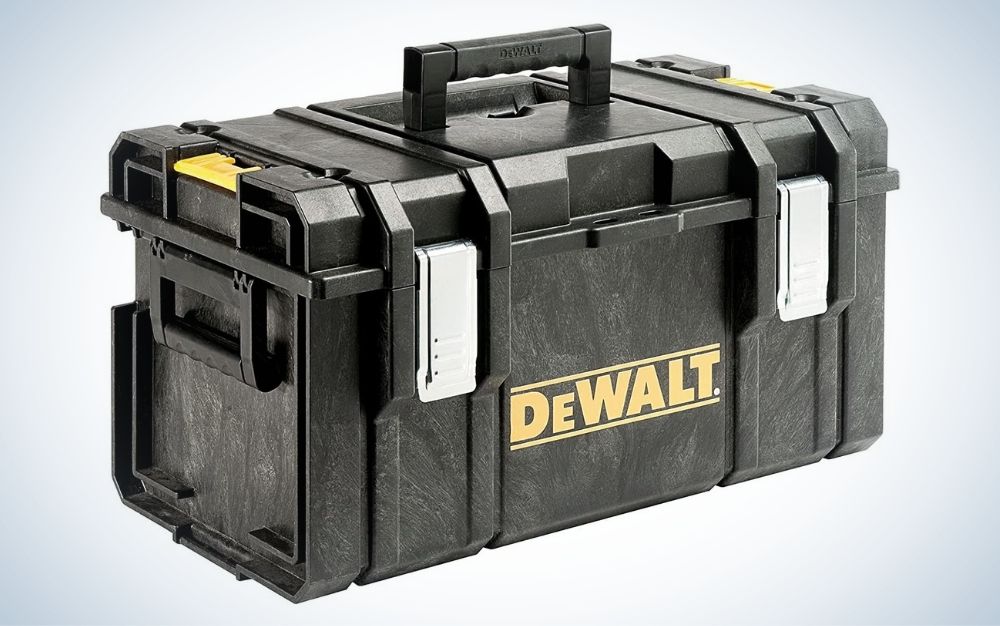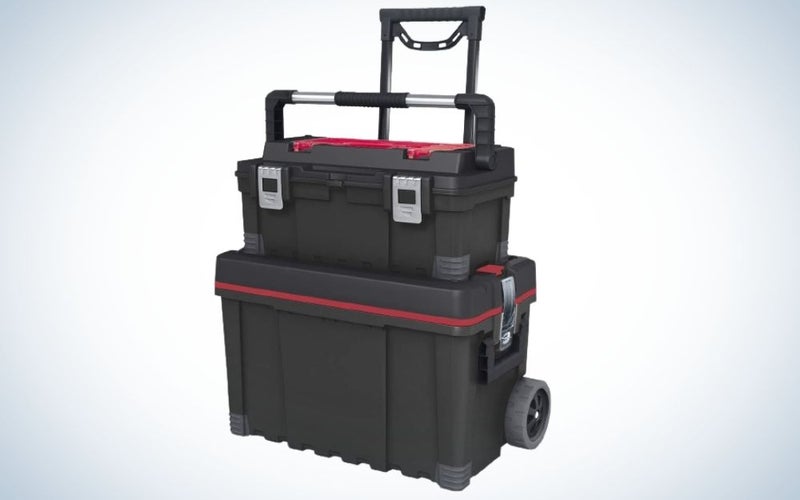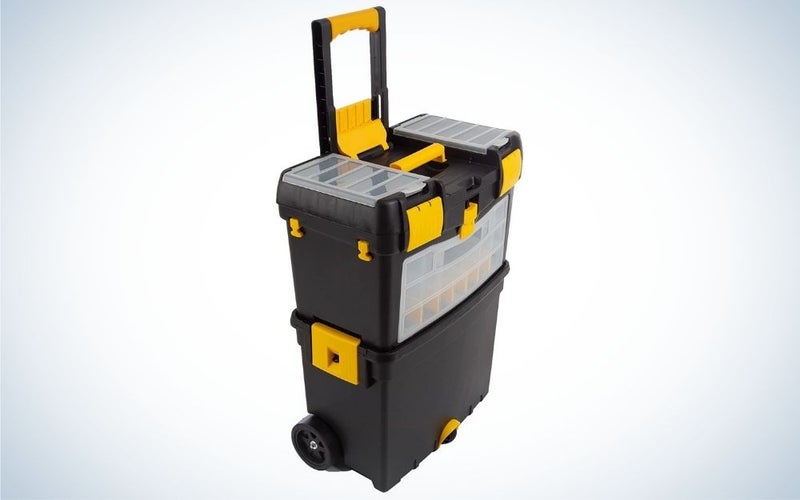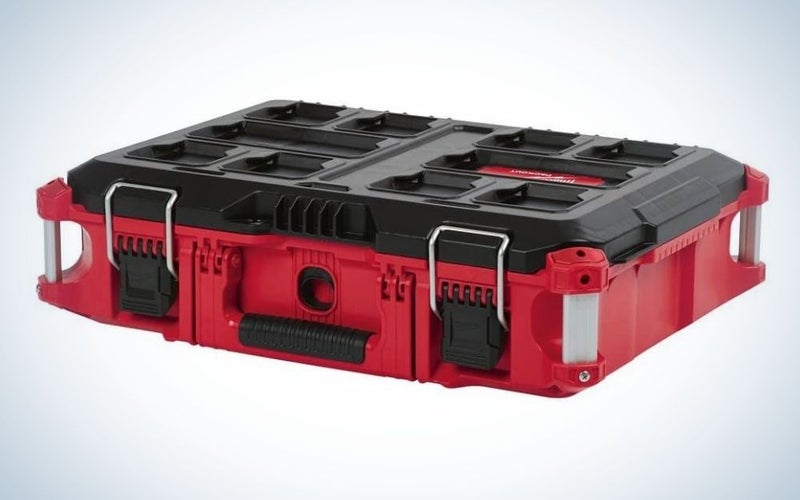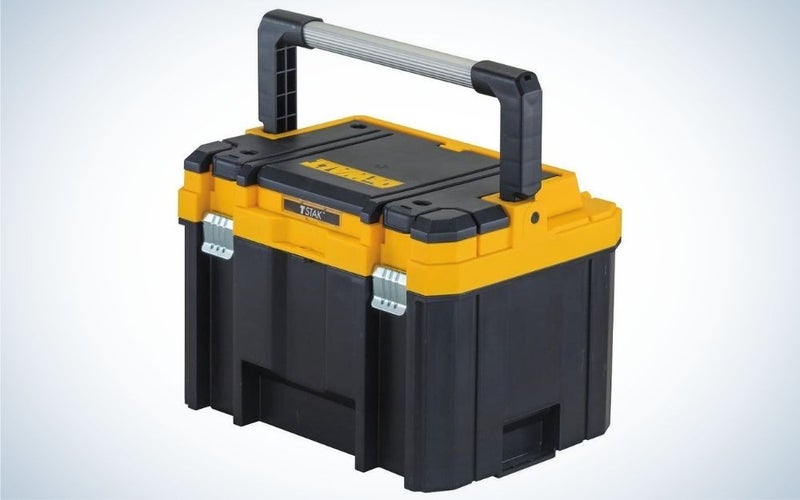We may earn revenue from the products available on this page and participate in affiliate programs. Learn more ›
Every home needs a tool box, but choosing the best one can be tricky. Almost every large tool manufacturer also produces at least one, which is why it’s easy to spot a Rigid, Craftsman, or Husky box given that these brands are popular options in many home improvement stores. With a wide range of options to choose from, it’s important to take your time, decide on the size, storage options, mobility, and type of box that you want or need for your workshop.
Keep in mind that the best tool box for your purposes may not be the largest or most expensive option. Instead, look for a storage solution that is easy to move, spacious enough for all of your tools, and flexible enough to keep everything organized and easy to grab when you’re deep in a project. The best tool boxes will save you time, which is essential if you need to quickly grab something in the middle of a project.
- Best overall: DeWalt Tough System
- Best rolling: Keter Mobile Hawk System
- Best organized: Stalwart Rolling Box
- Best portable: Milwaukee Modular Box
- Best budget: DeWalt TSTAK, Deep
How we chose the best tool boxes
Years of first-hand experience in the plumbing trade and as both a project manager and DIYer helped to form the basis for the selection criteria. Extensive research into each product helped us determine the dimensions, carrying capacity, construction, and if there were any useful additional features like storage compartments, extendable handles, or wheels.
We started with a list of more than 30 different boxes, including top options like DeWalt, Keter, Stalwart, and even a Westward. However, only the best models in each category were selected for this list. Extra options that helped products stand out from competitors included waterproofing, a stackable design, and built-in locks or locking clasps that could be used to prevent others from opening the box.
The best tool boxes: Reviews & Recommendations
By assessing the best tool boxes for multiple types of jobs at every available price point our recommendations cover all the bases for most people. In some cases you may want to get a couple of tool boxes—one that stays at home, and one to leave in your car, for example—to suit all of your needs.
Best overall: DeWalt Tough System
DEWALT
Why it made the cut: This tool box is made with lightweight, durable structural foam and features an integrated water seal to improve water resistance.
Specs
- Type: Hand-carry
- Material: Metal and structural foam
- Dimensions: 21.7 x 13.1 x 12.1 inches
Pros
- IP65 water-resistance and dust-resistance
- Deep compartment for power tool storage
- Durable, corrosion-resistant structural foam design
- Metal locking brackets
Cons
- Carrying it increases user fatigue
The DEWALT Tool Box is a medium-sized hand-carry case that’s a great choice for home use or on a busy job site. It comes with a deep storage compartment that is large enough to fit a drill, saw, or a cordless tool battery and a charger. Sitting on top of this compartment is a removable tray where users can store hand tools, like screwdrivers, wrenches, or a hammer. The tray doesn’t have any dividers, so it isn’t the best choice for carrying small fittings or fasteners.
This box employs the DeWalt Tough System, which essentially means that it’s made with durable structural foam that protects against impact damage, cuts, slices, dust, and water. The box features an integrated water seal that keeps water out so the tools stay dry, even while working in the rain or dealing with a flood at a plumbing job.
It measures 21.7 inches by 13.1 inches by 12.1 inches and weighs just 9.5 pounds. Made with metal locking brackets and awarded an IP65 water and dust resistance rating, this is an excellent option for DIYers and professionals. Just keep in mind that it doesn’t have wheels, so users will need to carry the box.
Best rolling: Keter Mobile Hawk System
Keter
Why it made the cut: Don’t struggle to carry a tool box around the job site when this Keter tool box system comes with built-in wheels to improve portability.
Specs
- Type: Rolling
- Material: Metal and plastic
- Dimensions: 25.4 x 14.7 x 25 inches
Pros
- Two modular tool boxes
- Wheeled design is easier to transport
- Includes bungee cord hooks, securing straps, and metal latches
- Extendable handle
Cons
- High price
Hand-carry tool boxes can be tiresome to lug around, but the Keter Mobile Hawk System comes with a set of built-in wheels and an extendable handle that makes it easy to simply roll the boxes around the job site, down the driveway, or across almost any flat surface.
The spacious main compartment has plenty of room for larger power tools. It also has a second, smaller box that connects to the top of the chest with the included bungee cord hooks, securing straps, and metal latches. This second box is suitable for hand tools, like screwdrivers, wrenches, and hammers, as well as fasteners, like nails and screws. The product measures 25.4 inches by 14.7 inches by 25 inches and it’s made primarily of plastic, though the handles and clasps are metal. Expect to pay a little more for this than some other options on the list, but you’re basically getting two boxes in one.
Best organized: Stalwart Rolling Box
Stalwart
Why it made the cut: Sort and organize power tools, hands tools, fasteners, and other small items with this impressive rolling tool storage system.
Specs
- Type: Rolling
- Material: Plastic
- Dimensions: 17.5 x 10 x 24.5 inches
Pros
- Wheeled design
- Two modular tool boxes
- Durable, rust-resistant plastic construction
- Many compartments and dividers for superior organization
Cons
- Light-duty product
The Stalwart Rolling Tool Storage System includes a large, wheeled tool chest where power tools, extension cords, and other bulky items can reside, as well as a second box that connects to the top of the tool chest. The whole setup rolls easily across any flat surface. This Stalwart box measures 17.5 inches by 10 inches by 24.5 inches and it weighs 13.5 pounds due to the light-duty plastic construction.
While the light-duty plastic is vulnerable to impact damage—it won’t survive a fall down the stairs—it is resistant to water. Just keep in mind that the tool storage system is not watertight and water can still leak in through the seams or other openings.
The top box has several compartments and dividers so that hand tools, fasteners, washers, drill bits, screwdriver bits, zip ties, and a wide variety of other small accessories and parts can be neatly organized and stored securely for quick retrieval when necessary.
Best portable: Milwaukee Modular Box
MILWAUKEE
Why it made the cut: Store hand tools, blades, fasteners, washers, drill bits, and more without sacrificing space with this compact tool box.
Specs
- Type: Hand-carry
- Material: Metal and plastic
- Dimensions: 20.2 x 15.8 x 6.3 inches
Pros
- Thick, durable plastic construction
- Multiple organizer trays
- Narrow profile for easy transportation and storage
- Metal locking brackets
Cons
- Carrying the tool box increases user fatigue
This Milwaukee box measures just 20.2 inches by 15.8 inches by 6.3 inches because not every DIYer needs a ton of space. Its slim profile allows it to fit in narrow spaces, like behind the passenger seat in a car or it could slide onto a shelf in the garage.
Despite the small size, this impressive Milwaukee Modular Box contains several organizer trays with multiple compartments, as well as a central storage compartment that is deep enough to hold a battery charger, spare battery, and an impact driver. The hand-carry box weighs 11 pounds, and it’s made of tough, durable plastic with metal clasps to ensure the tools are secure when they are not in use. This product is part of a modular storage system, so additional Milwaukee modular storage options can be added to increase storage and mobility but, currently, users will need to carry this box around the home or the job site.
Best budget: DeWalt TSTAK, Deep
DEWALT
Why it made the cut: The affordable price and high-quality of this DeWalt tool box make it ideal for new and experienced DIYers.
Specs
- Type: Hand-carry
- Material: Metal and plastic
- Dimensions: 17.8 x 13.3 x 12.6 inches
Pros
- Top-lid organizer for fasteners
- Deep compartment for power tool storage
- Affordable
- Lightweight
Cons
- Carrying it increases user fatigue
- No tool tray
This lightweight, rugged toolbox weighs just eight pounds, which lightens the load when carrying one or more bulky power tools. It measures 17.8 inches by 13.3 inches by 12.6 inches and it’s made of plastic with durable metal clasps. Users can store small fasteners in the top-lid organizer, but the box does not come with a tool tray, so hand tools should stay in a different box.
The DeWalt TSTAK Box is part of a modular line of DeWalt TSTAK products, including a four-wheel cart that can be used to improve the mobility of this box. It also has a long handle, so users don’t need to bend over as much to pick up the box, and it comes at an affordable choice, making it an attractive option for new and experienced DIYers.
Things to consider when buying the best tool boxes
Before deciding on a box, it’s important to keep in mind that there is an incredible range of options to choose from because basic designs have been around for years. Consider the type, material, dimensions, and tool organization options to find the best box for your workshop.
Tool box types
There are several different kinds of boxes that can be used at home or on the job site, including a tool bag or tool bucket, a hand-carry box, a rolling box, and a truck-mounted box.
- Tool bags and tool buckets are often used by plumbers and electricians because they are ideal for holding a small number of specialized tools for common repair or installation jobs. These products are tough, durable choices that can be banged or bumped on walls, floors, and other objects without breaking and even the tool bags are made with cut-resistant fabric to prevent tools from tearing through the bottom or sides.
- Hand-carry tool boxes traditionally fall into the classic tool box design, but you can find modern hand-carry tool boxes with a wide range of sizes, shapes, and compartments to keep your tools organized. Just keep in mind that you’ll have to carry it wherever you go, so make sure your forearms are up to the task.
- Rolling tool boxes also come in a variety of sizes and shapes, but mobility is the one distinct advantage they have over hand-carry tool boxes. These products can be bigger and bulkier than a hand-carry tool box because they come equipped with a set of wheels that makes it easy to move the tool box around the workshop, garage, or job site.
- Truck-mounted tool boxes are large, weather-resistant tool boxes that attach directly to the back of a pickup truck. These tool boxes are typically oversized, lockable steel boxes that are designed for carrying numerous power tools.
Material
You can find boxes that are made of wood, plastic, or metal, though most wooden ones are now considered more of a novelty than their more practical plastic or metal counterparts.
- Metal tool boxes are heavier than plastic, though they tend to weigh the same or less than wood tool boxes. These products are also more durable than both wood or plastic options, allowing them to hold up admirably in both home and job site environments. Just keep in mind that metal tool boxes can rust if they are not properly maintained. They can also dent, which can impair their functionality.
- Plastic tool boxes are lightweight and easy to carry. Many models come with wheels and extendable handles, making these products excellent options if you are looking for highly portable tool boxes. Plastic is also waterproof, though it is not as durable as metal or wood.
- Wood tool boxes are not very popular, though some avid DIYers like to use them because they are heavy, durable, and won’t rust. This makes them ideal for long-term storage in a shed or garage, though metal tools left for long periods will still be susceptible to rusting.
Dimensions, drawers, and dividers
The size of the box will be necessary to consider when it comes to the tools you want to store. If the box is too small, then there may be tools that don’t fit into the given space, while a box that is too large may be too difficult to move or lift. Also, keep in mind that if you want to take the tool box with you, then it will need to be able to fit into your vehicle. Similarly, it’s a good idea to make sure that the new box will have a suitable place in the workshop, shed, or garage that is out of the way of regular activity.
If you are looking for a box to carry large power tools, then drawers and dividers aren’t a big concern, but if you want to keep various hand tools, fasteners, and other small accessories, then it’s necessary to find a box with drawers, compartments, or dividers in order to neatly organize these smaller components.
FAQs
Q: How much does a good tool box cost?
A good box can range significantly in cost because you can find a small high-quality product for just $15, but as the size of the box increases, the price also increases, even if the overall quality remains the same. With this in mind, a large box of similar quality can cost over $100, especially if it is made with any extra features like wheels, waterproofing, or a modular design that allows more than one box to neatly stack for easy transportation and storage.
Q: How do you keep tools from rusting in a truck tool box?
You don’t want to have to worry about rust when you put your tools away and slide the box into the shed, garage, or basement until you need them again, so before closing the box, drop a few pieces of chalk into the box to help absorb the moisture. Replace the chalk every couple of months to keep the moisture levels low and prevent your tools from rusting.
Q: What type of tool boxes are used to carry a variety of hand tools?
A tool bag or tool bucket is a great choice if you are only carrying a few important hand tools for specific work, but if you need a box for a large number of hand tools, then it’s best to opt for a hand-carry, rolling, or truck-mounted box. It’s recommended to find a box with removable trays or compartments to store and organize your screwdrivers, wrenches, hammers, and other hand tools.
Q: How much does a toolbox cost?
This will depend on its size, purpose, and extra features. It’s possible to spend as little as $37 or close to $200 based on your needs.
Final thoughts on the best tool boxes
- Best overall: DeWalt Tough System
- Best rolling: Keter Mobile Hawk System
- Best organized: Stalwart Rolling Box
- Best portable: Milwaukee Modular Box
- Best budget: DeWalt TSTAK, Deep
You don’t have to be particularly handy to need a toolbox. Even smaller home repairs are made simpler by collecting all of your tools in a single place. If your hammer is in your closet but your screwdriver is in your junk drawer, you’re going to waste valuable time. A toolbox is also a way to keep yourself a little more organized, which can never hurt. If you’re working in wet environments or outdoors, the DeWalt Tough System is a great choice, with thick structural foam walls and an integrated water seal. However, if you just want a tough, durable box for around the home, consider the affordable DeWalt TSTAK.
Why trust us
Popular Science started writing about technology more than 150 years ago. There was no such thing as “gadget writing” when we published our first issue in 1872, but if there was, our mission to demystify the world of innovation for everyday readers means we would have been all over it. Here in the present, PopSci is fully committed to helping readers navigate the increasingly intimidating array of devices on the market right now.
Our writers and editors have combined decades of experience covering and reviewing consumer electronics. We each have our own obsessive specialties—from high-end audio to video games to cameras and beyond—but when we’re reviewing devices outside of our immediate wheelhouses, we do our best to seek out trustworthy voices and opinions to help guide people to the very best recommendations. We know we don’t know everything, but we’re excited to live through the analysis paralysis that internet shopping can spur so readers don’t have to.
